Topic: Lab The Beaks Of Finches
Lab The Beaks Of Finches
Finches on the Galapagos Islands are thought to have originated from South America and to have evolved into new species over the last 10,000 years. Some of this evolution is represented in the diagram below.
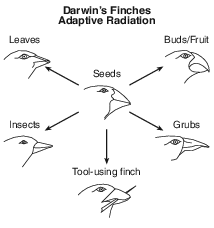
The success of the finches on the Galapagos was most likely due to the
(1) large numbers of other birds competing for food
(2) mutations occurring in every offspring
(3) birds occupying the same island
(4) birds adapting to different niches
The Galapagos Islands are home to many different species of finches. Three finch species, their relative beak sizes, and their food preferences are represented below. All three species live on the same island.

Which statement is correct concerning the nutritional preferences of these finches?
(1) The three species do not compete for food because they eat different types of foods.
(2) The vegetarian and cactus finches compete for food because they both feed on producers.
(3) The vegetarian and warbler finches compete for food because they both live in trees.
(4) The three species of finches compete for food because their beaks are similar in shape and size.


The diagram of the island suggests that in region B finches can feed on
(1) large seeds and insects
(2) small seeds, only
(3) a large variety of different-sized seeds
(4) insects and a limited number of small seeds

Based on the information in the chart, which statement is correct?
(1) Finches that eat animals always have larger beaks than finches that eat plants.
(2) Finches that eat plants all have very large beaks.
(3) Finches with crushing bills eat only animals for food.
(4) Finches with grasping bills usually eat animals for food.
The diagram below represents the relationship between beak structure and food in several species of finches found on the Galapagos Islands.

The different beak structures observed in the diagram are evidence of
(1) different species of finches adapting to different environments over many generations
(2) finches changing their beak characteristics so that they could feed efficiently
(3) finch species with different beak structures coming to the Galapagos Islands from the mainland
(4) finches mating with birds of other species and acquiring some of their traits
Certain chemicals, such as cytochrome C, are found within cells of all living organisms. The biochemical structure of cytochrome C in ground finches and in tree finches is very similar. This suggests that tree finches and ground finches have
(1) identical DNA
(2) a common ancestor
(3) evolved at the same time
(4) the same nesting site

Which species of finch has an edge-crushing bill that can also probe into plants for food?
(1) cactus finch
(2) sharp-billed ground finch
(3) warbler finch
(4) large ground finch
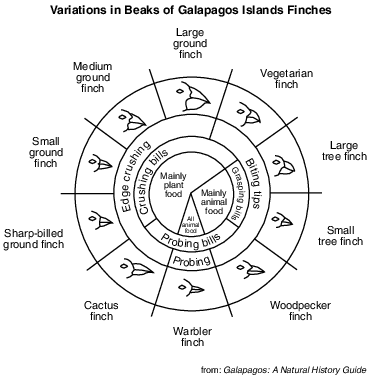
On an island populated by both warbler finches and small tree finches, there is a significant decrease in the amount of animal food. Which finch population would decrease more? Support your answer. [1]
Finch population: ________________________________________
Allow 1 credit for warbler finch and supporting the answer. Acceptable responses include, but are
• not limited to:
• — Small tree finches may eat some plant food, while warbler finches eat only animal food.
• — Warbler finches eat only animal food, while small tree finches may eat some plant food.
The chart describes the beaks of various types of birds that live in a small island ecosystem containing flowering land plants, aquatic plants, many small mammals, amphibians, and several species of trees.
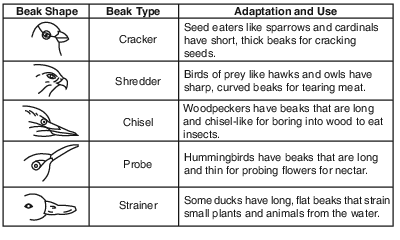
Identify the beak type that would be characteristic of predators of small mammals. [1]
___________________________________________
Allow 1 credit. Acceptable responses include, but are not limited to:
• — shredder
• — sharp, curved beak

There are a number of islands in the Galapagos that these finches could possibly inhabit. Explain why each island would not be expected to have all of the species shown. [1]
Allow 1 credit. Acceptable responses include, but are not limited to:
• — Each island has its own set of environmental conditions which might not provide food or
• shelter for some of these species.
• — Different islands might have different kinds of food available.
• — too much competition
Identify one trait, other than a beak characteristic, that could affect the survival of a finch. Support your answer. [1]
Allow 1 credit for identifyng one trait, other than beak characteristic, that could affect the survival
• of a finch and supporting the answer. Acceptable responses include, but are not limited to:
• Coloration:
• — Camouflage would help survival.
• — attract a mate for successful reproduction
• Strength:
• — helps in competition for food
• Aggressiveness:
• — helps in competition for mate/food
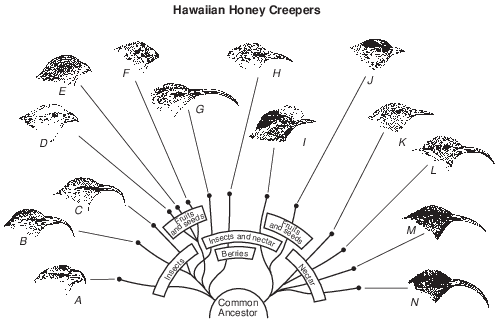
Describe how the beaks of the bird species D, E, F, and J that eat fruits and seeds differ from the beaks of the bird species that eat only nectar. [1]
Allow 1 credit. Acceptable responses include, but are not limited to:
• — Fruit and seed eaters have shorter, thicker beaks.
• — The nectar-eating birds have longer, thinner beaks.
• — Their beaks are shorter.
Identify one adaptation, other than beak size and shape, a finch species might possess and state how that would aid in its survival. [1]
Allow 1 credit. Acceptable responses include, but are not limited to:
• Adaptation: fast flight speed
• — to escape predators
• Adaptation: camouflage
• — to hide from predators
• Adaptation: eyesight
• — to locate food
• Adaptation: mating behavior (songs)
• — to attract mates
A certain small population of finches already has an “ideal” beak type for its present environment. Describe two specific adaptations, other than beak type, that would contribute to the ability of these finches to survive. [1]
Allow 1 credit for two adaptations. Acceptable responses include, but are not limited to:
• — better eyesight to locate food
• — ability to produce more offspring
• — ability to fly faster
• — resistance to diseases in the area
• — ability to tolerate hot/cold temperatures
A species of bird lives on an island. Beak thickness varies within the population. The birds feed mainly on seeds. Birds with smaller beaks can eat only small seeds. Only birds with larger beaks are able to crush and eat large seeds.
During years with more rain, small seeds are abundant. During dry years, there are very few small seeds, but there are many large seeds.
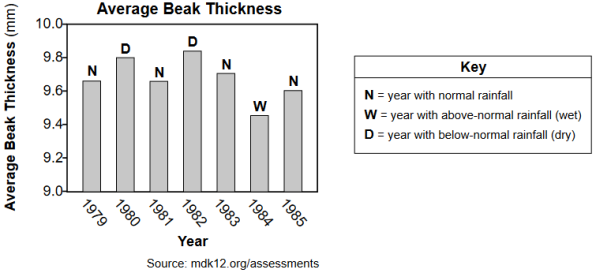
Predict how the average beak thickness would be expected to change after 1985 if there were eight very dry years in a row. Support your answer. [1]
Allow 1 credit for predicting how the average beak thickness would be expected to change and
• supporting the answer with information from the graph. Acceptable responses include, but are not limited to:
• — The average thickness of the beaks would be around or greater than 9.8 mm, as it was in
• the two dry years shown in the graph.
• — The average thickness would increase since the beaks were thicker in the dry years shown
• in the graph.
• — During dry years (1980 and 1982), the beaks were thicker. After a series of dry years, beaks
• would be thicker.
